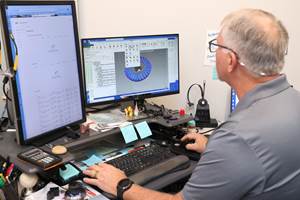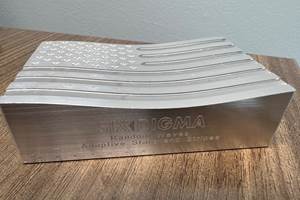“Turning” the Tables: 10 Must-Read Articles to Sharpen Your Lathe Game
From complex Swiss-type lathes to turning basics, we’ve rounded up 10 turning articles for both beginners and advanced machinists.
Share






Whether you're new to the world of turning or a seasoned machinist looking to tighten your tolerances, there are always more ideas to turn over in your mind. From mastering Swiss-type machines to considerations when buying a lathe, we’ve gathered 10 standout articles that cover turning basics and beyond. This list contains practical tips, expert advice and a look at emerging technologies — all designed to help you get the most out of your lathe operations.
Machining 101: What is Turning?

Turning uses a lathe to remove material from the outside of a rotating workpiece, while boring does the same from the inside of a rotating workpiece. Learn more in this article about the basics of turning.

This Swiss-type requires only 120 volts of power, basic compressed air supply, weighs in at 150 pounds and needs a table that’s just two by four feet. Learn more about this desktop lathe from APSX in this article.
Choosing Your Carbide Grade: A Guide

Without an international standard for designating carbide grades or application ranges, users must rely on relative judgments and background knowledge for success. In this article, we breakdown what constitutes a carbide grade and how each element influences different aspects of machining.

In this article, Vallorbs Jewel Company gives their suggestions on training employees on a Swiss-type lathe.
Second B-Axis Improves Efficiency of Swiss-Type Machining

In this article, learn how a highly stable, fully programmable B-axis on the subspindle of Nomura DS’s 20J3XBTC enables users to more quickly machine complex parts complete.

This technology uses a laser to act as a cutting tool to "turn" parts from solid barstock. This high-speed precision turning machine is especially useful for micromachining, enabling high accuracy for small, complex parts that are often delicate and difficult to machine when implementing conventional turning processes.
Buying a Lathe: The Basics
 Source: Getty Images
Source: Getty ImagesLathes represent some of the oldest machining technology, but it’s still helpful to remember the basics when considering the purchase of a new turning machine.

In the late 1800s, a new technology — Swiss-type machines — emerged to serve Switzerland’s growing watchmaking industry. Today, Swiss-machined parts are ubiquitous, and there’s a good reason for that: No other machining technology can produce tiny, complex components more efficiently or at higher quality.
How to Start a Swiss Machining Department From Scratch

When Shamrock Precision needed to cut production time of its bread-and-butter parts in half, it turned to a new type of machine tool and a new CAM system. Here’s how the company succeeded, despite the newness of it all.

There can be hidden issues using legacy cam-driven lathes that can be overcome using new CNC technology. Here are three to keep in mind.
Related Content
View From My Shop: The Challenge of a One-Man Machine Shop
Mason Montalvo took up the challenge of starting his own shop running manual machine tools to produce complex parts.
Read MoreTTI Brings Specialty Gear Production In-House with Multiaxis Machining
By investing in a 3+2-axis machine and utilizing simulation software for diagnostic checks, Techtronic Industries turned a four- to ten-week lead time into a one- to two-week lead time.
Read MoreBuilding Machines and Apprenticeships In-House: 5-Axis Live
Universal machines were the main draw of Grob’s 5-Axis Live — though the company’s apprenticeship and support proved equally impressive.
Read MoreInverting Turning and Five-Axis Milling at Famar
Automation is only the tip of the iceberg for Famar, which also provides multitasking options for its vertical lathes and horizontal five-axis machine tools.
Read MoreRead Next
A New Frontier in Surface Finish Control
What if your machine tool could measure surface roughness as it cuts? This article explores how in-process metrology is advancing from concept to reality, enabling real-time feedback, immediate detection of anomalies and new levels of control over surface quality. Discover the technologies making this possible.
Read MoreHow I Made It: Dennis Rymanowski
Dennis Rymanowski has worked at NSH USA for 60 years, with his passion for manufacturing living alongside his passion for his family’s polka band.
Read More


















